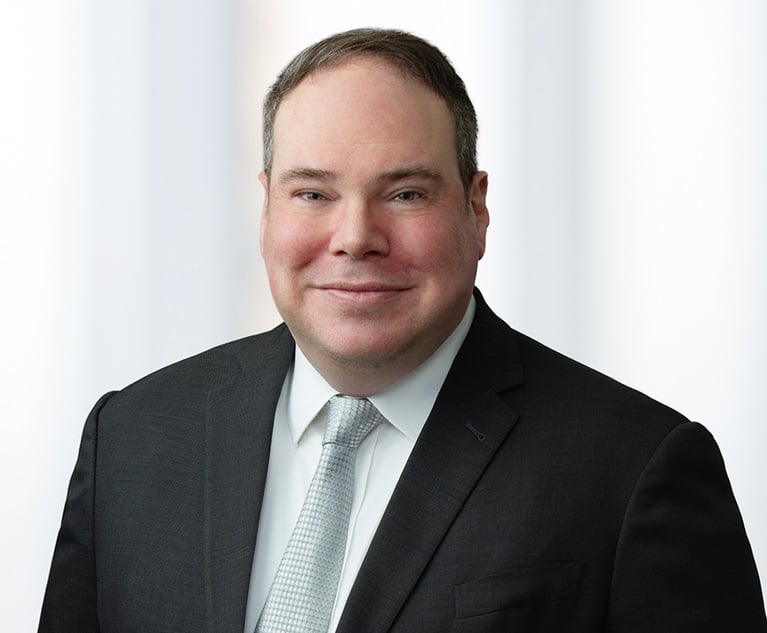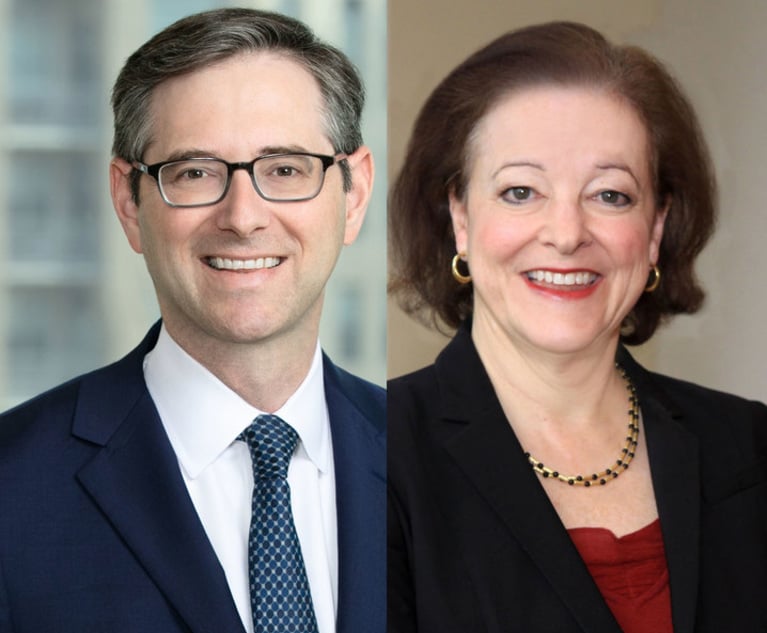Lawyers Help Turn Dallas Golf Course Built on Old Landfill Into Reality
What once was an abandoned landfill located south of downtown Dallas has become a links-style golf course that, beginning May 14, will host the AT&T Byron Nelson tournament for its 50th anniversary run.
May 11, 2018 at 03:41 PM
9 minute read

What once was an abandoned landfill located south of downtown Dallas has become a links-style golf course that, beginning May 14, will host the AT&T Byron Nelson tournament for its 50th anniversary run. “In the range of 20 lawyers” worked to turn what at first may have seemed like a long-odds proposition of building a course to attract PGA tournaments into reality, said Haynes and Boone Dallas tax partner Jeff Dorrill, lead attorney for the project.
Dorrill said he got the first call about the project in July 2012 from Jonas Woods, founder, president and chief executive officer of Dallas-based Woods Capital. Woods, who by his own estimation has been involved in one way or another in about a dozen golf course developments, had called to talk about building a golf course on a sand-capped landfill in South Dallas.
“It seemed like a challenge,” Dorrill said.
Calling it a challenge may have been an understatement. Dorrill and Matt Martin, a shareholder in Addison Law in Dallas who also was involved in legal work for the golf course, recently likened working on the project to trying to solve a Rubik's Cube.
“There's a lot of parties involved that all had needs,” said Martin, who along with the Haynes and Boone lawyers represented the Company of Trinity Forest Golfers Inc., which manages the golf course.
The parties involved in the approximately $33 million project include the city of Dallas, owner of the land; Southern Methodist University, which uses the facility as the home course for its golf teams; the PGA Tour; AT&T, sponsor of the Byron Nelson tournament; the Salesmanship Club of Dallas, which runs the tournament; the First Tee of Greater Dallas, a nonprofit initiative that strives to introduce young people to golf; and the Company of Trinity Forest Golfers Inc., the not-for-profit corporation that leases the property where the golf course is located.
Woods, president of Trinity Forest Golf Club, said that when he found the site for the golf course, he was looking for something that would meet the size and dimension requirements for hosting a PGA tournament, be close to downtown Dallas and was located on the city's southside.
“When I found the site, I didn't realize it was a landfill,” Woods said. “It was kind of like a rolling meadow.”
Coore & Crenshaw partners Bill Coore and Ben Crenshaw, who had 19 PGA Tour victories over his three decades as a professional golfer, designed the 18-hole golf course, which opened in October 2016. The planning and development of the course took several years.
According to a briefing paper presented to the Dallas City Council on Dec. 5, 2012, the project focused on Dallas Mayor Mike Rawling's Grow South initiative, which focused on economic development in the southern part of Dallas and involved the city leasing the approximately 400-acre property to a not-for-profit tenant for 40 years beginning with a base lease of $1,000 and increasing to $10,000 per year when the course opened. Before any work could begin on the golf course, the city had to remediate the landfill site, which the Texas Commission on Environmental Quality had cited for violations.
As noted in the 2012 briefing paper, the city was to provide up to $12 million for costs related to the preliminary site work, landfill remediation, wetland and flood plain mitigation and roadway improvements. Backers of the project were expected to raise another $20 million in private funds for it.
“Jonas [Woods] and his team were able to bring in and commit more funding than he was required to do,” Dorrill said.
AT&T also agreed to provide an additional $2.5 million for the third phase of the city's Trinity Trails System, which winds around, but not through, the golf course.
One of the first things the Haynes and Boone lawyers had to do, Dorrill said, was draft a memorandum of understanding that outlined the key terms that would be required in the agreement with the city. The lease with the city, which was signed in May 2013, required the golf club to reach agreements with the PGA Tour and the Salesmanship Club to secure relocation of the Byron Nelson tournament to the new course, an agreement with First Tee for establishment of its facilities for youths at the course and an agreement with SMU for its golf complex to be located there.
Jordan Bailey, a former Haynes and Boone associate who worked on the project, said the key agreement with SMU defined the university's rights to use the golf course.
“It's their home course,” Dorrill said. “They wanted to know it would be available when SMU golf teams wanted to use it.”
“SMU also wanted the right to hold tournaments,” added Bailey.
Although Trinity Forest Golf Club is a private club, Dorrill said that it was important to the city and the club that there be public use of the facilities. As noted in an April 26, 2013, memorandum presented to the Dallas City Council, at least 25 percent of the annual rounds of golf are to be available for public play. That requirement had to be included in the agreement with the city.
“We put it all into words that everybody is happy with,” Dorrill said.
Haynes and Boone also represented the golf club in negotiating its right to have Cameron McCormick, Texas pro golfer Jordan Spieth's swing coach, as its head golf pro.
Bruce Merwin, a former Haynes and Boone attorney now a Houston partner at Thompson & Knight in Houston, did much of the lawyering required for construction of the golf course, including working with the owner's construction manager. As Merwin pointed out, preparing and negotiating a golf course construction project is different than for a commercial building like a hotel because a golf course is more like a civil engineering project.
“Every hole is different,” he said.
Trinity Forest Golf Course is even more unique because it's built on a landfill, and physical characteristics of the site resulted in challenges that had to be addressed in the contract documents, Merwin said. He had to make sure the architects and contractor were aware of the issues, which entailed, in part, his review of all the specifications written by the architect and revision of some of the specifications.
“I wanted a contract that was clear and unambiguous as to the responsibilities of the contractor to perform the work pursuant to the drawings and specifications,” he said.
Following the contractor's review of the drawings and specifications, the contractor provides the owner with qualifications, clarifications and exclusions modifying or limiting the contractor's obligations to perform various aspects of the work, Merwin explained.
“One of my key jobs was to discuss the effect of such qualifications, clarifications and exclusions on the cost and timing of the project with the owner, the architect and the owner's construction manager and help resolve any open issues with respect to such items,” he noted.
It was also important to coordinate the roles of the owner, contractor, architect and construction manager, according to Merwin.
Merwin also had to make sure the contract included insurance requirements, the contractor's indemnification of the owner and warranty, as well as procedures for change orders.
Working on the golf course project forced the lawyers to get creative at times. Martin said he faced several challenges while working to obtain liquor licenses for the golf club from the Texas Alcoholic Beverage Commission.
“It was kind of like 'Whack a Mole,'” he said. “As soon as one problem goes down, another pops up.”
Martin said the club property straddles both sides of Loop 12, but it would not work to have two different licensed premises. That would prohibit a customer from taking alcoholic beverages purchased at the club on one side of the loop to the portion of the club on the other side. The solution to that problem was to describe the club's premises to include both sides, he said.
A second challenge came up because the golf course didn't have its clubhouse completed when the course opened in 2016. The club initially used a big tent for its clubhouse. Martin said the city would not let the club have a kitchen in the tent, even though the club had to have a kitchen to meet the TABC's requirements.
“We installed a food truck outside the tent, so we could cook the food and bring it inside,” Martin said. “As far as we know, it's the first time the TABC has ever licensed a food truck.”
Martin also encountered some excitement when he and one of the club's construction management staff members posted the permit signs as required by TABC. The two men posted one sign at the club's main entrance on the south side of Loop 12 and then crossed the busy road on foot to post a sign on the north side of the loop, he said.
“We're dodging cars on the road to put up signs,” Martin said. “It's usually not such hazardous duty, but that day it was.”
All of the efforts by the various lawyers involved in the project to get Trinity Forest Golf Club constructed as well as up and running did not escape Woods' attention.
“They did a phenomenal job on a very complicated transaction,” Woods said.
This content has been archived. It is available through our partners, LexisNexis® and Bloomberg Law.
To view this content, please continue to their sites.
Not a Lexis Subscriber?
Subscribe Now
Not a Bloomberg Law Subscriber?
Subscribe Now
NOT FOR REPRINT
© 2025 ALM Global, LLC, All Rights Reserved. Request academic re-use from www.copyright.com. All other uses, submit a request to [email protected]. For more information visit Asset & Logo Licensing.
You Might Like
View All

Eversheds Sutherland Adds Hunton Andrews Energy Lawyer With Cross-Border Experience
3 minute read
Ex-Marathon General Counsel Takes Legal Reins of Another Energy Company

After Nearly 2 Decades in the Role, Longtime Haynes and Boone General Counsel Passes the Baton
3 minute readTrending Stories
Who Got The Work
Michael G. Bongiorno, Andrew Scott Dulberg and Elizabeth E. Driscoll from Wilmer Cutler Pickering Hale and Dorr have stepped in to represent Symbotic Inc., an A.I.-enabled technology platform that focuses on increasing supply chain efficiency, and other defendants in a pending shareholder derivative lawsuit. The case, filed Oct. 2 in Massachusetts District Court by the Brown Law Firm on behalf of Stephen Austen, accuses certain officers and directors of misleading investors in regard to Symbotic's potential for margin growth by failing to disclose that the company was not equipped to timely deploy its systems or manage expenses through project delays. The case, assigned to U.S. District Judge Nathaniel M. Gorton, is 1:24-cv-12522, Austen v. Cohen et al.
Who Got The Work
Edmund Polubinski and Marie Killmond of Davis Polk & Wardwell have entered appearances for data platform software development company MongoDB and other defendants in a pending shareholder derivative lawsuit. The action, filed Oct. 7 in New York Southern District Court by the Brown Law Firm, accuses the company's directors and/or officers of falsely expressing confidence in the company’s restructuring of its sales incentive plan and downplaying the severity of decreases in its upfront commitments. The case is 1:24-cv-07594, Roy v. Ittycheria et al.
Who Got The Work
Amy O. Bruchs and Kurt F. Ellison of Michael Best & Friedrich have entered appearances for Epic Systems Corp. in a pending employment discrimination lawsuit. The suit was filed Sept. 7 in Wisconsin Western District Court by Levine Eisberner LLC and Siri & Glimstad on behalf of a project manager who claims that he was wrongfully terminated after applying for a religious exemption to the defendant's COVID-19 vaccine mandate. The case, assigned to U.S. Magistrate Judge Anita Marie Boor, is 3:24-cv-00630, Secker, Nathan v. Epic Systems Corporation.
Who Got The Work
David X. Sullivan, Thomas J. Finn and Gregory A. Hall from McCarter & English have entered appearances for Sunrun Installation Services in a pending civil rights lawsuit. The complaint was filed Sept. 4 in Connecticut District Court by attorney Robert M. Berke on behalf of former employee George Edward Steins, who was arrested and charged with employing an unregistered home improvement salesperson. The complaint alleges that had Sunrun informed the Connecticut Department of Consumer Protection that the plaintiff's employment had ended in 2017 and that he no longer held Sunrun's home improvement contractor license, he would not have been hit with charges, which were dismissed in May 2024. The case, assigned to U.S. District Judge Jeffrey A. Meyer, is 3:24-cv-01423, Steins v. Sunrun, Inc. et al.
Who Got The Work
Greenberg Traurig shareholder Joshua L. Raskin has entered an appearance for boohoo.com UK Ltd. in a pending patent infringement lawsuit. The suit, filed Sept. 3 in Texas Eastern District Court by Rozier Hardt McDonough on behalf of Alto Dynamics, asserts five patents related to an online shopping platform. The case, assigned to U.S. District Judge Rodney Gilstrap, is 2:24-cv-00719, Alto Dynamics, LLC v. boohoo.com UK Limited.
Featured Firms
Law Offices of Gary Martin Hays & Associates, P.C.
(470) 294-1674
Law Offices of Mark E. Salomone
(857) 444-6468
Smith & Hassler
(713) 739-1250






